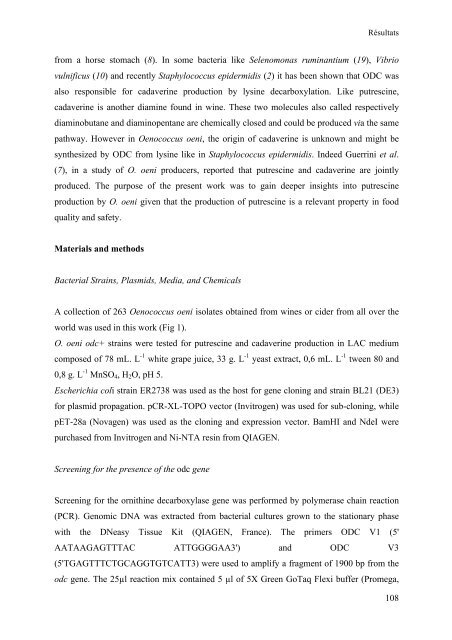THESE Maryse Bonnin Jusserand - Université de Bourgogne
THESE Maryse Bonnin Jusserand - Université de Bourgogne
THESE Maryse Bonnin Jusserand - Université de Bourgogne
You also want an ePaper? Increase the reach of your titles
YUMPU automatically turns print PDFs into web optimized ePapers that Google loves.
Résultats<br />
from a horse stomach (8). In some bacteria like Selenomonas ruminantium (19), Vibrio<br />
vulnificus (10) and recently Staphylococcus epi<strong>de</strong>rmidis (2) it has been shown that ODC was<br />
also responsible for cadaverine production by lysine <strong>de</strong>carboxylation. Like putrescine,<br />
cadaverine is another diamine found in wine. These two molecules also called respectively<br />
diaminobutane and diaminopentane are chemically closed and could be produced via the same<br />
pathway. However in Oenococcus oeni, the origin of cadaverine is unknown and might be<br />
synthesized by ODC from lysine like in Staphylococcus epi<strong>de</strong>rmidis. In<strong>de</strong>ed Guerrini et al.<br />
(7), in a study of O. oeni producers, reported that putrescine and cadaverine are jointly<br />
produced. The purpose of the present work was to gain <strong>de</strong>eper insights into putrescine<br />
production by O. oeni given that the production of putrescine is a relevant property in food<br />
quality and safety.<br />
Materials and methods<br />
Bacterial Strains, Plasmids, Media, and Chemicals<br />
A collection of 263 Oenococcus oeni isolates obtained from wines or ci<strong>de</strong>r from all over the<br />
world was used in this work (Fig 1).<br />
O. oeni odc+ strains were tested for putrescine and cadaverine production in LAC medium<br />
composed of 78 mL. L -1 white grape juice, 33 g. L -1 yeast extract, 0,6 mL. L -1 tween 80 and<br />
0,8 g. L -1 MnSO4, H2O, pH 5.<br />
Escherichia coli strain ER2738 was used as the host for gene cloning and strain BL21 (DE3)<br />
for plasmid propagation. pCR-XL-TOPO vector (Invitrogen) was used for sub-cloning, while<br />
pET-28a (Novagen) was used as the cloning and expression vector. BamHI and N<strong>de</strong>I were<br />
purchased from Invitrogen and Ni-NTA resin from QIAGEN.<br />
Screening for the presence of the odc gene<br />
Screening for the ornithine <strong>de</strong>carboxylase gene was performed by polymerase chain reaction<br />
(PCR). Genomic DNA was extracted from bacterial cultures grown to the stationary phase<br />
with the DNeasy Tissue Kit (QIAGEN, France). The primers ODC V1 (5'<br />
AATAAGAGTTTAC ATTGGGGAA3') and ODC V3<br />
(5'TGAGTTTCTGCAGGTGTCATT3) were used to amplify a fragment of 1900 bp from the<br />
odc gene. The 25µl reaction mix contained 5 µl of 5X Green GoTaq Flexi buffer (Promega,<br />
108

















